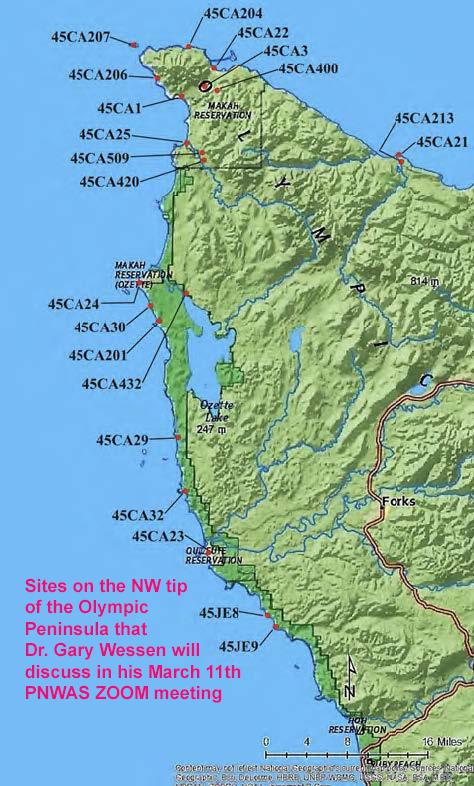PNWAS ZOOM Meeting
Thursday March 11th 2021
starting at 6:30 with program at 7:00 PM
To join the ZOOM Meeting and see the presentation
please become a member today!
Thursday March 11th 2021
starting at 6:30 with program at 7:00 PM
To join the ZOOM Meeting and see the presentation
please become a member today!
Makahs, Quileutes, and the Precontact History of the Northwestern Olympic Peninsula, Washington
By Dr. Gary Wessen,
Wesson and Associates, Inc., Port Townsend
By Dr. Gary Wessen,
Wesson and Associates, Inc., Port Townsend
Variations on the related ideas that: (a) the Makah people arrived on the northwestern Olympic Peninsula of Washington as recently as 1,000 years ago and (b) they displaced Quileute people who had previously held those lands have appeared on a few occasions during the last century. As offered, such claims rely heavily on ethnographic and linguistic arguments. A detailed examination shows that all of these arguments are flawed. The currently available archaeological data is not sufficient to address these ideas in an unequivocal way but may still offer relevant insights. Doing so, however, requires some ability to recognize these groups in the archaeological record; this possibility is explored using the artifact and faunal assemblages from this region. Preliminary findings suggest that Makahs and/or other Wakashan speakers have been present for at least 3,000 to 4,000 years and that there is no credible evidence for an earlier presence of Quileutes and/or other Chimakuan speakers.
This ZOOM presentation examines some existing ideas about the late precontact culture history of the northwestern Olympic Peninsula of Washington (see map, above). The area under consideration includes the coastal margins of the traditional territories of two neighboring groups: the Makah and Quileute peoples. For the most part, it consists of exposed, steep, rocky shorelines marked by numerous nearshore rocks and small islands (see photos). Low, sandy beaches occur in some places, but they are often small. Terrestrial surfaces farther inland are mostly steep and heavily forested. On the north, a few small coastal river valleys break up this pattern. Farther south, the much larger Quillayute and Hoh Rivers reach the ocean on relatively broad alluvial flats.
This ZOOM presentation examines some existing ideas about the late precontact culture history of the northwestern Olympic Peninsula of Washington (see map, above). The area under consideration includes the coastal margins of the traditional territories of two neighboring groups: the Makah and Quileute peoples. For the most part, it consists of exposed, steep, rocky shorelines marked by numerous nearshore rocks and small islands (see photos). Low, sandy beaches occur in some places, but they are often small. Terrestrial surfaces farther inland are mostly steep and heavily forested. On the north, a few small coastal river valleys break up this pattern. Farther south, the much larger Quillayute and Hoh Rivers reach the ocean on relatively broad alluvial flats.

 RSS Feed
RSS Feed
